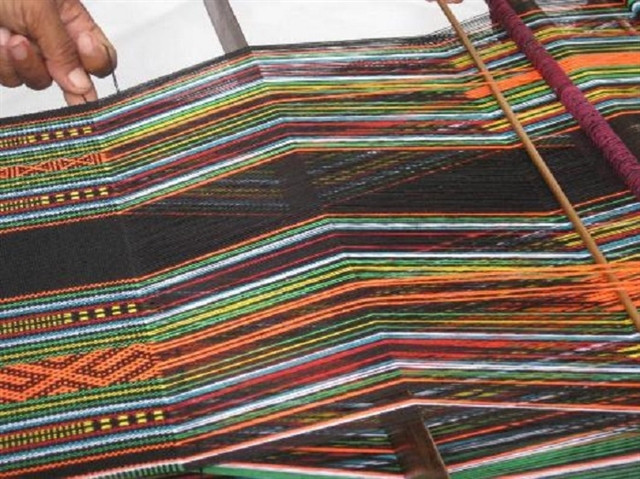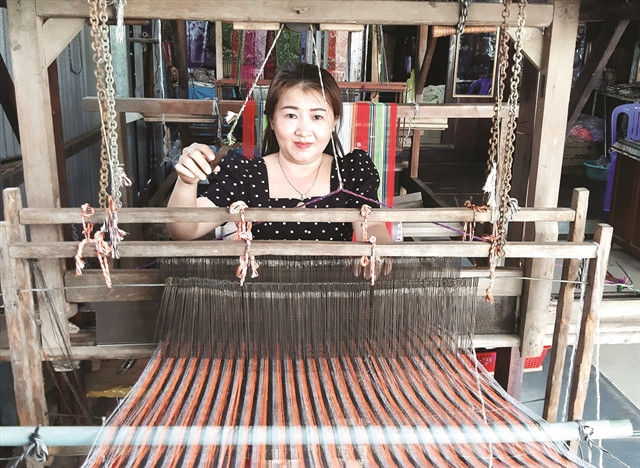 |
| Mohamad displays Chăm fabric products for tourists. Photo baodantoc.vn |
The development of community-based tourism associated with folk culture has improved the quality of life of the Chăm ethnic minority people in the southern province of An Giang.
The Chăm people inhabit areas along both sides of the Châu Giang River across An Phú and Châu Thành districts and Tân Châu Township.
Despite various ups and downs in history, the Chăm people in An Giang continue to preserve the traditional cultural values, customs and habits of their ancestors.
With unique cultural values, Chăm craft villages have attracted the attention of tourists, both local and international, in recent years.
Châu Phong Commune in Tân Châu is among the most popular destinations famous for the handloom fabric weaving of Chăm ethnic people.
According to Mohamad, a native of the commune [who has only one name], in addition to the two traditional products -- sarongs and bandanas -- his facility also produces trendy items, such as bags, backpacks, hats, and keychains.
The wide selection of affordable products, ranging from VNĐ20,000 to 200,000 per item, is very much embraced by foreign tourists looking for souvenirs abroad.
 |
| Many tourists find these products affordable and make for great souvenirs. Photo congluan.vn |
“Currently, advanced equipment produces fabrics faster and more convenient. However, I still keep the traditional handloom weaving as a way to preserve the cultural values of the Chăm people," Mohamad says, admitting that it is more expensive this way.
To increase visitors’ experiences, Mohamad also restored a wedding room in the ethnic Chăm style for tourists, especially couples, to take souvenir photos while cooperating with a number of local chefs to prepare some typical Chăm dishes, including curries, tossing ovens, cakes and desserts.
Tourist Trần Kim Huệ from HCM City says that visiting the craft village of the Chăm in Châu Phong commune has been a memorable experience.
“I never thought craft village tourism would be so interesting. Not only did I discover the unique culture of the Chăm people, I also bought a lot of souvenirs as gifts for my family and friends," she says.
 |
| Visitors are able to experience traditional weaving when visiting Châu Phong Commune. Photo baodantoc.vn |
The Chair of the Châu Phong Commune People’s Committee, Võ Thụy Ý Như, says that thanks to Mohamad’s innovation and creativity, the craft village has attracted an increasing number of tourists every day.
In addition to Châu Phong, the Chăm village of Đa Phước is widely known among tourists, with an average of 3,000 visitors per month.
Currently, Đa Phước has two wharves, making it convenient for visitors travelling by boat to tour handloom weaving workshops in the village.
With the new community tourism model being applied to Đa Phước, the lives of the Chăm locals have been significantly improved.
A resident of Đa Phước Village, Ysa [who has only one name], is pleased to see how handloom weaving products such as sarongs, towels and shirts, and other traditional crafts, have now become more preferable by many tourists.
“The development of community-based tourism associated with traditional culture not only helps the Chăm ethnics earn more income and improve their quality of life, but also helps people here to be bolder and more confident in communication. There are many Chăm people who have risen to success," Ysa notes.
In fact, about 25 households in Cồn Tiên raft village nearby currently live by transporting tourists from HCM City and Châu Đốc to Bè and Đa Phước villages every day.
Due to the increasing travel needs, some local households have pursued aquaculture while selling ethnic products and serving meals to visitors right on the raft to earn stable income.
An Giang Province has 14 craft villages and 15 traditional craft villages which are recognised by the Provincial People's Committee, with 3,706 production and business households and 11,482 workers.
In recent years, An Giang has added many new craft villages with distinguished handicraft products such as Uzu mats from Tân Châu Town, jaggery leaf paintings from Tri Tôn District and hyacinth pins from Thoại Sơn District.
They are made from locally available materials, gaining popularity among international tourists. VNS